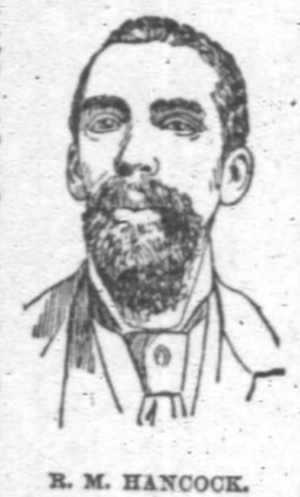Richard Mason Hancock facts for kids
Quick facts for kids
Richard Mason Hancock
|
|
|---|---|

Hancock in 1890
|
|
| Born | November 22, 1832 New Bern, North Carolina, U.S.
|
| Died | June 5, 1899 (aged 66) |
| Occupation | carpenter, pattern-maker, shop foreman |
| Political party | Republican |
Richard Mason Hancock (November 22, 1832 – June 5, 1899) was a skilled carpenter and a shop foreman. He was also an important civil rights activist in the American Northeast and Chicago. He was one of the few African-American shop foremen in iron works during his time.
Contents
Richard Hancock's Early Life
Richard Mason Hancock was born on November 22, 1832. His birthplace was New Bern, North Carolina. His parents were free African Americans. Richard went to private schools because public schools did not allow black children.
When he was thirteen, he began training as a carpenter. He learned from his father, William H. Hancock. He also learned from a builder named Uriah Sandy. During his training and early jobs, he learned many skills. These included pattern-making, carpentry, math, and drawing plans.
Hancock's Career Journey
As a young man, Richard moved to New Haven, Connecticut. He worked for two companies there, Atwater & Treat and Doolittle & Company. Both were white-owned businesses. In 1856, he spoke out against the American Colonization Society in New Haven. This group wanted to send free black people to Africa.
He then moved to Lockport, New York. There, he worked on ship carpentry and canal boats. Later, he worked for Birdsill Holly at Holly Manufacturing Company. This is where he became very good at pattern-making.
Working in Chicago's Iron Industry
In 1862, Richard Hancock moved to Chicago. He started working as a pattern-maker for P. W. Gates. Gates was an abolitionist and president of Eagle Works Manufacturing Company. Richard worked as a journeyman for two years. Then, he was promoted to foreman, which meant he was in charge of the shops.
However, the white employees refused to work under him. After three days of this, Richard went to Gates to quit his job. Instead, Gates hired new pattern-makers to replace the striking workers. Richard Hancock continued his important role as foreman.
In 1873, Eagle Works closed down. Two superintendents from the company, Thomas Chalmers and David Ross Fraser, started a new company. It was called Liberty Iron Works. Richard Hancock moved with them and continued as a foreman. His son, George, also worked there as a pattern-maker.
Richard Hancock's Family Life
Richard's first wife was Mary B. Beman. She was the oldest daughter of Reverend Amos Gerry Beman. Richard and Mary lived in Lockport, New York. They had two children, Fanny and George. Mary passed away in Lockport on July 9, 1861.
He later married Jane Watkins in Chicago on June 6, 1867. Jane died on April 20, 1879.
On April 26, 1881, he married Gertrude E. Gross in Cincinnati, Ohio. Gertrude was the widow of Reverend Tabbs Gross. Richard adopted Gertrude's daughter, Constance Gross. In 1900, Gertrude was known as the president of a group called "Workers for the King circle of the King's Daughters." This was the oldest society for colored people in this order worldwide.
Public Life and Community Work
Richard Hancock's successful work brought him much respect and wealth. He was an active member of the Republican Party. He also served as vice-president of the Provident Hospital and Training School in Chicago. This hospital was created for African Americans.
Richard was also a freemason. He was a member of St. Thomas' Episcopal Church.
Richard Hancock's Death
Richard Mason Hancock died on June 5, 1899, in Chicago. He passed away from stomach cancer. His funeral was held at St. Thomas' Episcopal Church. He is buried in Oak Woods Cemetery in Chicago.

